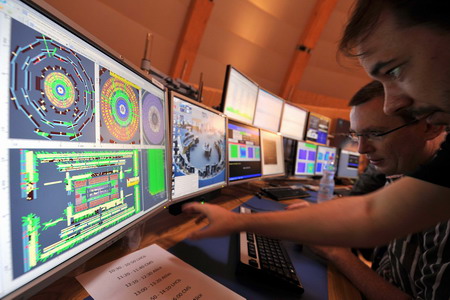 |
|
Scientists look at a computer screen at the control centre of the CERN in Geneva September 10, 2008. Scientists at the European Organisation for Nuclear Research (CERN) started up a huge particle-smashing machine on Wednesday, aiming to re-enact the conditions of the "Big Bang" that created the universe. [Agencies]
|
GENEVA: "Alice in Wonderland" completed its first major test successfully, with the world's largest particle collider firing a beam of protons all the way around a 27-km tunnel Wednesday.
Scientists say the world's biggest scientific, or the "Big Bang", experiment in four major installations in a tunnel - ALICE, or "A Large Ion Collider Experiment" - is the next great step to understanding the make-up of the universe.
Skeptics, however, fear the collision of protons would create a black hole that could imperil the earth or even suck it in entirely. They say a byproduct of the collisions could be micro black holes, sub-atomic versions of collapsed stars whose gravity is so strong they can suck in planets and other stars.
After a series of trial runs, two white dots flashed on a computer screen at 10:36 am (16:36 Beijing time) Wednesday, indicating the protons had traveled the full length of the $3.8-billion Large Hadron Collider.
"There it is," project leader Lyn Evans said when the beam completed its lap.
Champagne corks popped in labs as far away as Chicago, US, where contributing scientists watched the proceedings via satellite. Physicists around the world now have much greater power than ever before to smash the components of atoms together in attempts to see how they are made.
"Well done, everybody," said Robert Aymar, director-general of the European Organization for Nuclear Research, to cheers from the assembled scientists in the collider's control room at the Swiss-French border.
The organization, known by its French acronym CERN, began firing the protons - a type of subatomic particle - around the tunnel in stages less than an hour earlier.

